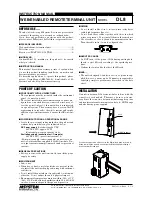
Section 8. Operation
454
5. When CardOut() or TableFile() with Option 64 is used but the card is not
present, zero bytes are reported in the Status table.
6. In both the internal memory and memory card data-table spaces, about 2 KB
of extra space is allocated (about 100 extra records in the above example) so
that for the ring memory the possibility is minimized that new data will
overwrite the oldest data when datalogger support software
tries to collect the
oldest data at the same time. These extra records are not reported in the
Status table and are not reported to the datalogger support software and
therefore cannot be collected.
7. If the CardOut() or TableFile() with Option 64 instruction is set for fill-and-
stop, all the space reserved for records on the card is recorded before the
writing of final-data to memory stops, including the extra 2 kB allocated to
alleviate the conflict of storing the newest data while reading the oldest when
the area is not fill-and-stop, or is ringing around. Therefore, if the CPU does
not stop earlier, or is ring and not fill-and-stop, then more records will be
stored on the card than originally allocated, i.e., about 2 KB worth of records,
assuming no lapses. At the point the writing of final-data stops, the CR3000
recalculates the number of records, displays them in the Status table, and
advertises a new table definition to the datalogger support software. Further,
if the table is storing relatively fast, there might be some additional records
already stored in the CPU buffer before final-data storage stops altogether,
resulting in a few more records than advertised able to be collected. For
example — on a CR3000 storing a four-byte value at a 10 ms rate, the CPU
not set to fill-and-stop, CRD: set to fill-and-stop after 500 records — after
final-data storage stopped, CRD: had 603 records advertised in the Status
table (an extra 103 due to the extra 2 KB allocated for ring buffering), but 608
records could be collected since it took 50 ms, or 5 records, to stop the CPU
from storing its 5 records beyond when the card was stopped.
8. Note that only the CRD: drive will keep storing until all its records are filled;
the CPU: drive will stop when the programmed number of records are stored.
9. Note that the O command in the terminal mode helps to visualize more
precisely what CPU: drive and the CRD: drive are doing, actual size allocated,
where they are at the present, etc.
8.8.4 Resetting the CR3000
A reset is referred to as a "memory reset." Be sure to backup the current CR3000
configuration before a reset in case you need to revert to the old settings.
The following features are available for complete or selective reset of CR3000
memory:
•
Full memory reset
•
Program send reset
•
Manual data-table reset
•
Formatting memory drives
Summary of Contents for CR3000 Micrologger
Page 2: ......
Page 3: ......
Page 4: ......
Page 6: ......
Page 30: ......
Page 34: ......
Page 36: ......
Page 96: ......
Page 485: ...Section 8 Operation 485 8 11 2 Data Display FIGURE 110 Keyboard and Display Displaying Data ...
Page 487: ...Section 8 Operation 487 FIGURE 112 CR1000KD Real Time Custom ...
Page 491: ...Section 8 Operation 491 FIGURE 116 Keyboard and Display File Edit ...
Page 496: ......
Page 502: ......
Page 564: ...Section 11 Glossary 564 FIGURE 126 Relationships of Accuracy Precision and Resolution ...
Page 566: ......
Page 594: ......
Page 598: ......
Page 600: ......
Page 602: ......
Page 624: ......
Page 642: ......
Page 643: ......
















































